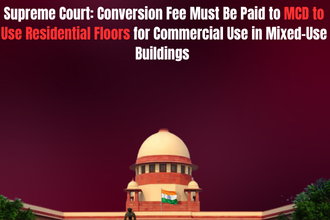In a significant ruling that impacts thousands of shop-owners and mixed-use property holders in Delhi, the Supreme Court of India has held that conversion charges must be paid to the Municipal Corporation of Delhi (MCD) before using residential floors for commercial purposes, even in mixed-use or shop-cum-residential (SCR) complexes. The judgment was delivered on October 31, 2025, in the long-running public interest litigation MC Mehta v. Union of India, which has monitored environmental compliance and unauthorized construction in the national capital for decades.
A Bench of Chief Justice of India BR Gavai and Justice K Vinod Chandran dismissed a plea seeking de-sealing of a property in New Rajinder Nagar, which had been sealed because its upper floors—sanctioned for residential use—were being used commercially.
Background of the Case
The matter stems from the extensive monitoring carried out by the Supreme Court in the MC Mehta environmental litigation initiated in 1985. Over time, this case expanded to include oversight of:
- Misuse of residential premises for commercial activity
- Unauthorized constructions
- Zoning and land-use violations
- Environmental and urban planning norms across Delhi
In 2006, the Supreme Court appointed a Monitoring Committee, which sealed numerous residential properties being used commercially without authorization. Later, in 2022, a Judicial Committee was established to review de-sealing and regularization requests on a case-by-case basis.
Facts of the Present Case
The applicant owned a property at Plot No. 106, New Rajinder Nagar Market, consisting of lower floors used for commercial purposes and upper floors originally sanctioned as residential space. The property was sealed by the MCD for misuse of the residential portion for commercial activity.
The applicant argued:
- The market was intended to be fully commercial.
- Historical records dating back to 1957 and 1987 allowed commercial activity.
- A 2023 order of the Judicial Committee supported full commercialization of similar markets.
However, the MCD opposed the application, stating:
- The building was classified as shop-cum-residential, not wholly commercial.
- Upper floors were sanctioned as residential and could only be converted upon payment of conversion charges under the Master Plan for Delhi, 2021.
- The applicant had exceeded the permissible Floor Area Ratio (FAR) and built additional structures without permission.
Key Supreme Court Findings
The Supreme Court upheld the MCD’s position and made several critical observations:
1. Conversion Requires Payment of Conversion Charges
The Court held:
“The upper (residential) floors though eligible for conversion to commercial space, it can happen only with payment of the conversion charge.”
This means mixed-use permission is not automatic. Even if commercial activity is permitted in the locality, conversion of residential floors to commercial use must follow due procedure and payment of charges to MCD.
2. Excess FAR Must Be Regularized
Under the Master Plan, commercial floors may have an FAR of 100 sq. meters, while residential floors may go up to 300 sq. meters. The property in question had an FAR of 162 sq. meters on upper floors—beyond commercial limit.
The Court ruled:
“The additional FAR as built and existing in excess of that sanction will have to be regularized by paying penalty charges and any non-compoundable constructions must be removed.”
3. Judicial Committee Orders Cannot Override Plot-Specific Records
The applicant’s reliance on a general Judicial Committee observation that the “market is commercial” was rejected because:
- The Committee’s order categorizes markets generally, not individual properties.
- The applicant’s own sanctioned plans showed kitchens and bedrooms on upper floors, proving they were originally residential.
4. New Rajinder Nagar Is a Designated LSC, Not a Fully Commercial Market
Under the Master Plan for Delhi, 2021:
| Category | Commercial Use Allowed |
|---|---|
| Planned Local Shopping Centre (LSC) | All floors commercial |
| Designated LSC (mixed-use) | Only ground floor commercial; upper floors need conversion |
The Court held that New Rajinder Nagar falls under the Designated LSC category, where upper floors remain residential unless converted with charges.
Court’s Directions
The Supreme Court directed the MCD to:
- Conduct a joint inspection of the property.
- Identify non-compoundable violations (which must be removed).
- Calculate and notify:
- Conversion charges
- Penalty for excess FAR
- Give the applicant reasonable time to comply.
- Permit commercial use only after compliance.
Impact of the Ruling
This judgment has wide implications across Delhi, particularly for:
- Properties in markets like Karol Bagh, Lajpat Nagar, Rajouri Garden, Kamla Nagar, and New Rajinder Nagar.
- Shop owners using upper floors for showrooms, boutiques, offices, or coaching centres.
- Owners who expanded buildings beyond sanctioned FAR.
Key Takeaways
- Mixed-use areas do not automatically allow unrestricted commercial use.
- Conversion charges are mandatory for changing residential floors to commercial use.
- Excess FAR must be regularized before conversion is permitted.
- Unauthorized or non-compoundable construction is liable to be removed.
Conclusion
The Supreme Court’s ruling clarifies the balance between commercial growth and planned urban development. While commercial activities are permitted in mixed-use areas, they must comply with regulatory frameworks under the Master Plan for Delhi and MCD norms.
This decision reinforces that legal authorization and payment of mandatory conversion charges are prerequisites for converting residential floors to commercial use—ensuring fairness, zoning compliance, and planned city development.
Also Read
Supreme Court Confers Senior Advocate Designation on Five Retired High Court Judges



